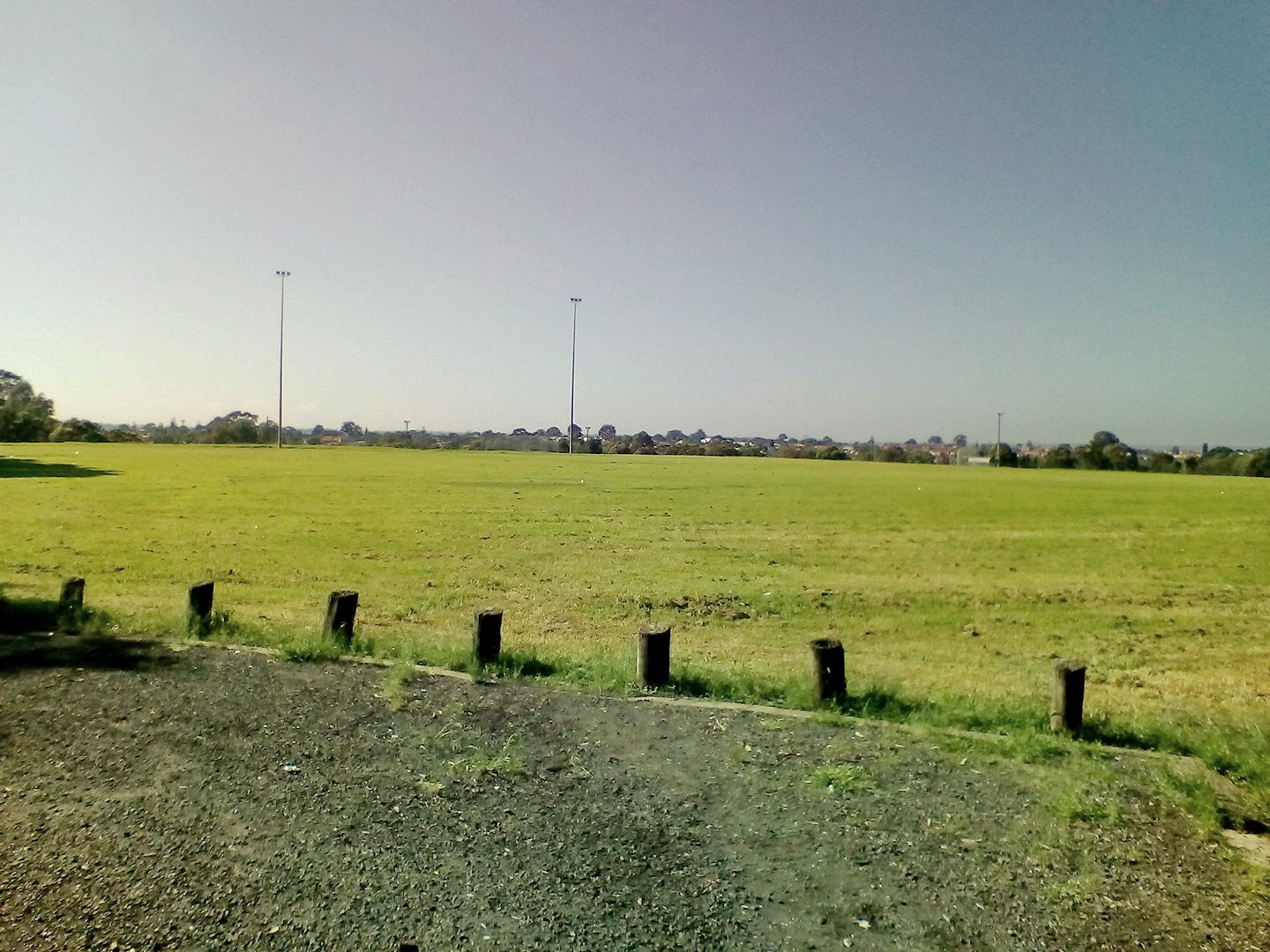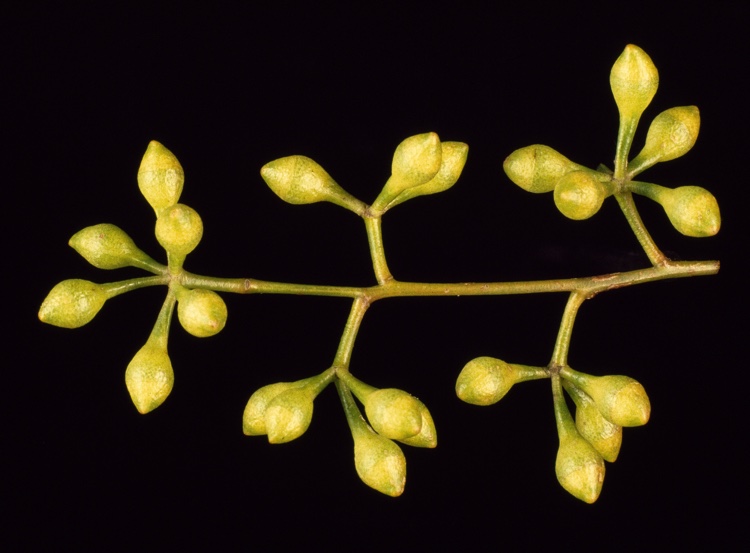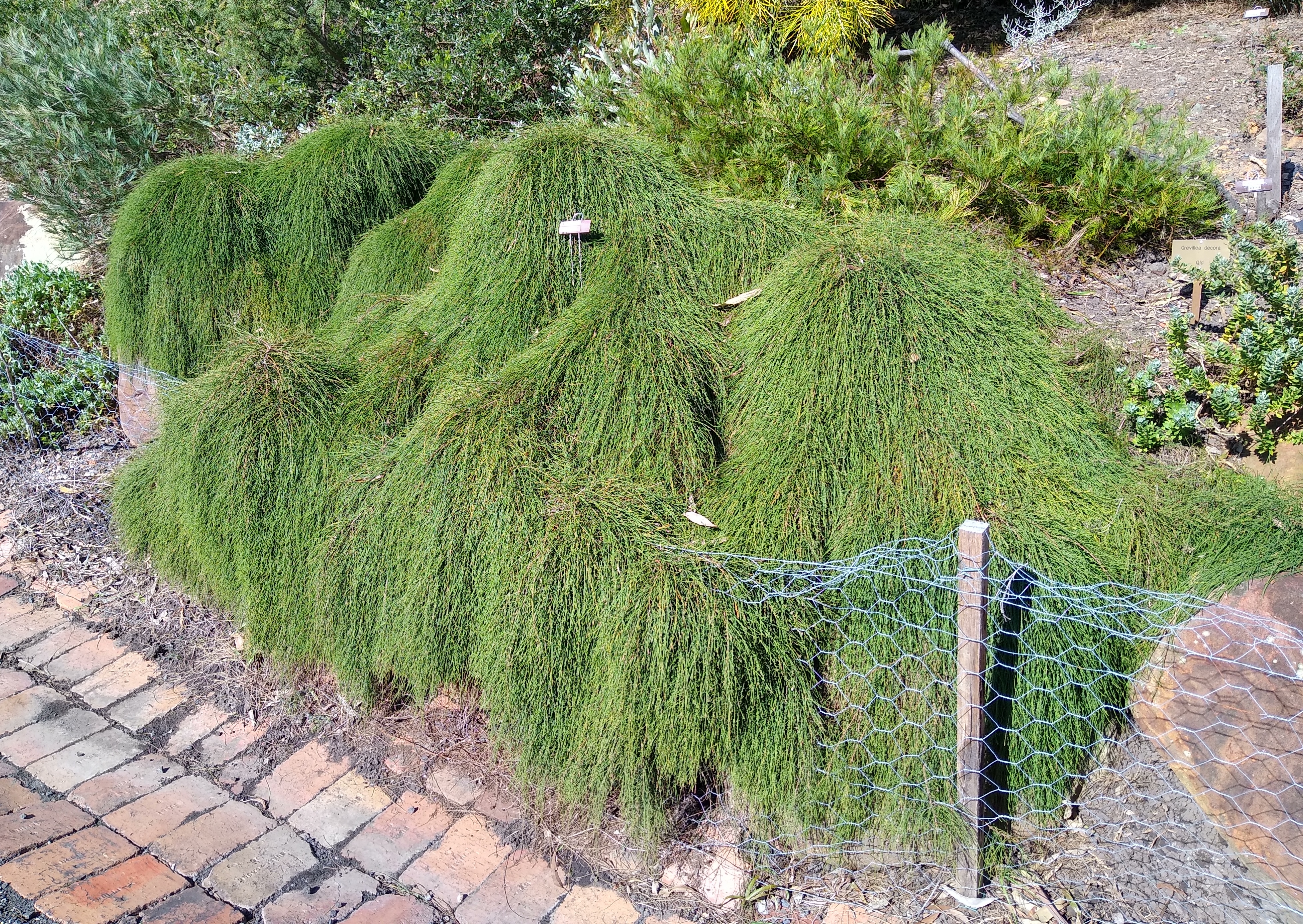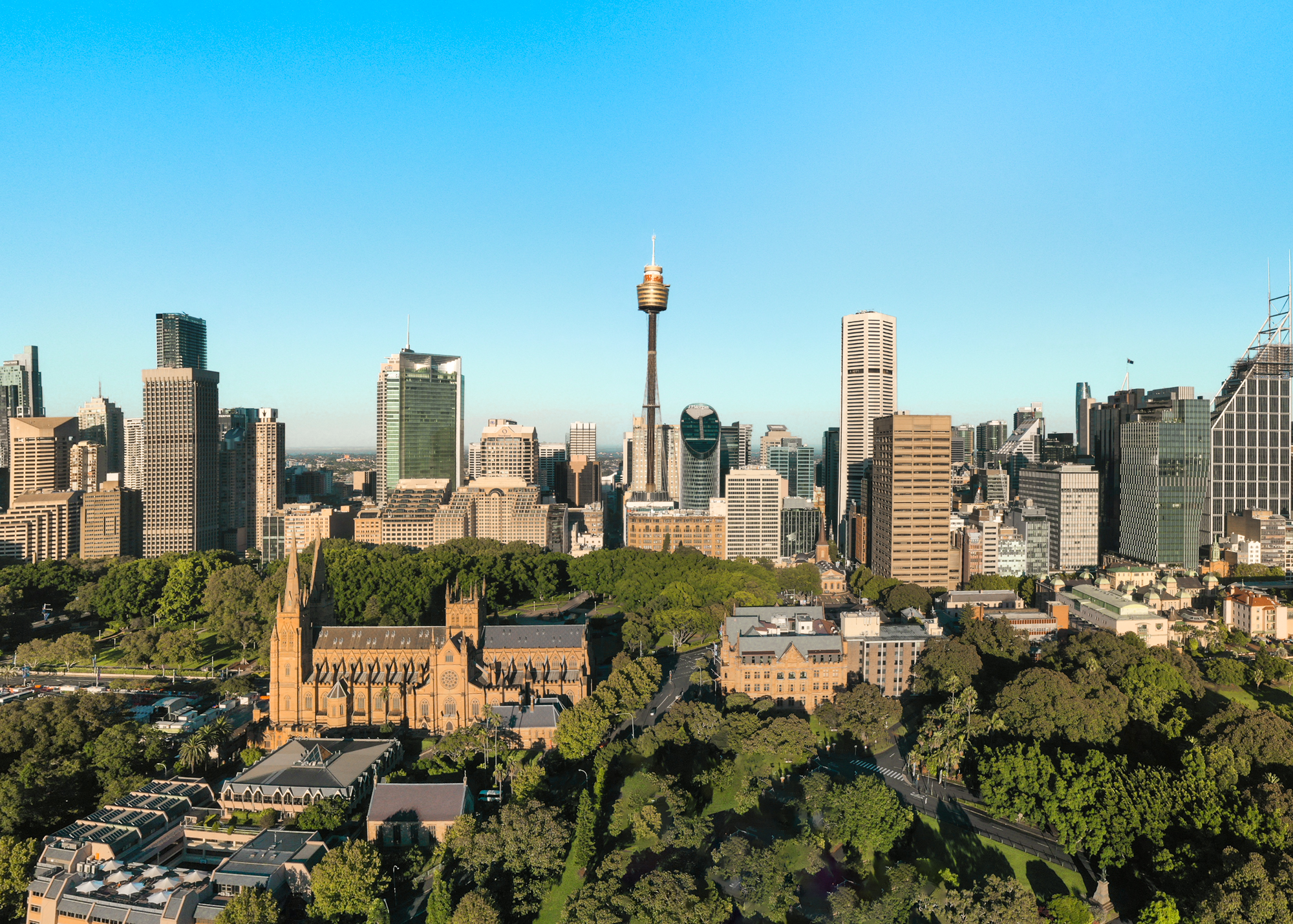|
Brenan Park
Brenan Park is a urban park situated in the western suburbs of Sydney, New South Wales, Australia. Primarily categorised as a sports field, the reserve contains an open grassland, bushland and recreational areas within the vicinity of native plants, such as eucalyptus trees. It is named after John Ryan Brenan, who founded the suburb of Smithfield in 1836. Artificially terraced, Brenan Park was established in the early 1980s and it is one of the largest reserves in the City of Fairfield, and one of the largest non-golf course green spaces in the Western Sydney region. History The shape of Brenan Park appears on the first survey design, in 1838, of the market town sketched for John Ryan Brenan. Brenan Park was planned to be a housing subdivision and a market area in 1938, with its triangular shape fashioned to take advantage of the topography and views of the surrounding district. The housing subdivision was never constructed. The site was used as a sewage disposal depot a ... [...More Info...] [...Related Items...] OR: [Wikipedia] [Google] [Baidu] |
Urban Park
An urban park or metropolitan park, also known as a municipal park (North America) or a public park, public open space, or municipal gardens ( UK), is a park in cities and other incorporated places that offer recreation and green space to residents of, and visitors to, the municipality. The design, operation, and maintenance is usually done by government agencies, typically on the local level, but may occasionally be contracted out to a park conservancy, "friends of" group, or private sector company. Common features of municipal parks include playgrounds, gardens, hiking, running and fitness trails or paths, bridle paths, sports fields and courts, public restrooms, boat ramps, and/or picnic facilities, depending on the budget and natural features available. Park advocates claim that having parks near urban residents, including within a 10-minute walk, provide multiple benefits. History A park is an area of open space provided for recreational use, usually owned and maintain ... [...More Info...] [...Related Items...] OR: [Wikipedia] [Google] [Baidu] |
Cumberland Highway
The Cumberland Highway is a long urban highway located in Sydney, New South Wales, Australia. The highway links the Pacific Highway (A1/B83) and Pacific Motorway ( M1) at Pearces Corner, Wahroonga in the northeast with the Hume Highway (A22/A28) at Liverpool in the southwest. The entire length of Cumberland Highway is designated route A28. The name of the highway is derived from the Cumberland Plain and Cumberland County. The name ''Cumberland'' was conferred on the County by Governor Arthur Phillip in honour of Ernest Augustus, Duke of Cumberland. History The original western Sydney Bypass was Ring Road 5, which ran from the Pacific Highway and the Hume Highway with Parramatta in between. In 1974, Ring Road 5 was superseded by State Route 55. The growth of Sydney's west had instead turned it into a primary arterial with huge increase in freight traffic. Construction In December 1981, Old Windsor Road was realigned at its southern end. A section of new road was construc ... [...More Info...] [...Related Items...] OR: [Wikipedia] [Google] [Baidu] |
Eucalyptus Bosistoana
''Eucalyptus bosistoana'', commonly known as the coast grey box or Bosisto's box, is a tree that is endemic to south-eastern Australia. It has rough, flaky bark at the base of its trunk, smooth cream yellow or grey bark above and sometimes throughout, the smooth bark shed in ribbons. The adult leaves are lance-shaped to curved and the flower buds are arranged in groups of seven. The flowers are white and the fruit is a cup-shaped, barrel-shaped or hemispherical capsule. Description ''Eucalyptus bosistoana'' is the largest of the "box" group of eucalypts, grows to a height of up to with a stem diameter of at least and forms a lignotuber. The bark on the lower part of the trunk is thin, greyish brown, rough and flaky. The bark on the upper part of the trunk and on the branches is smooth, white, cream-coloured or grey and is shed in ribbons. Sometimes all the bark is smooth. Young plants and coppice regrowth have rounded stems and oblong to elliptic or egg-shaped, pale gre ... [...More Info...] [...Related Items...] OR: [Wikipedia] [Google] [Baidu] |
Lomandra
''Lomandra'', commonly known as mat rushes, is a genus of perennial, herbaceous monocots in the family Asparagaceae, subfamily Lomandroideae. There are 51 species, all of which are native to Australia; two of them also extend into New Guinea and New Caledonia. They are generally tufted dioecious perennials with long narrow blade-like leaves that arise from a central stemless base and have thick woody rhizomes and fibrous roots. Taxonomy Now in the Asparagaceae, this genus was formerly assigned to the family Dasypogonaceae, Xanthorrhoeaceae, or Liliaceae The lily family, Liliaceae, consists of about 15 genera and 610 species of flowering plants within the order Liliales. They are monocotyledonous, perennial, herbaceous, often bulbous geophytes. Plants in this family have evolved with a fair a .... Species According to the ''World Checklist of Selected Plant Families'', there are 51 species recognised :, search for "''Lomandra''" References ''Lomandra''.FloraBase ... [...More Info...] [...Related Items...] OR: [Wikipedia] [Google] [Baidu] |
Acacia
''Acacia'', commonly known as the wattles or acacias, is a large genus of shrubs and trees in the subfamily Mimosoideae of the pea family Fabaceae. Initially, it comprised a group of plant species native to Africa and Australasia. The genus name is New Latin, borrowed from the Greek (), a term used by Dioscorides for a preparation extracted from the leaves and fruit pods of ''Vachellia nilotica'', the original type of the genus. In his ''Pinax'' (1623), Gaspard Bauhin mentioned the Greek from Dioscorides as the origin of the Latin name. In the early 2000s it had become evident that the genus as it stood was not monophyletic and that several divergent lineages needed to be placed in separate genera. It turned out that one lineage comprising over 900 species mainly native to Australia, New Guinea, and Indonesia was not closely related to the much smaller group of African lineage that contained ''A. nilotica''—the type species. This meant that the Australasian lineage (by ... [...More Info...] [...Related Items...] OR: [Wikipedia] [Google] [Baidu] |
Paperbark
''Melaleuca'' () is a genus of nearly 300 species of plants in the myrtle family, Myrtaceae, commonly known as paperbarks, honey-myrtles or tea-trees (although the last name is also applied to species of ''Leptospermum''). They range in size from small shrubs that rarely grow to more than high, to trees up to . Their flowers generally occur in groups, forming a "head" or "spike" resembling a brush used for cleaning bottles, containing up to 80 individual flowers. Melaleucas are an important food source for nectarivorous insects, birds, and mammals. Many are popular garden plants, either for their attractive flowers or as dense screens and a few have economic value for producing fencing and oils such as "tea tree" oil. Most melaleucas are endemic to Australia, with a few also occurring in Malesia. Seven are endemic to New Caledonia, and one is found only on (Australia's) Lord Howe Island. Melaleucas are found in a wide variety of habitats. Many are adapted for life in swamps ... [...More Info...] [...Related Items...] OR: [Wikipedia] [Google] [Baidu] |
Callistemon Viminalis
''Melaleuca viminalis'', commonly known as weeping bottlebrush or creek bottlebrush, is a plant in the myrtle family Myrtaceae, and is endemic to New South Wales, Queensland and Western Australia. (Some Australian state herbaria continue to use the name ''Callistemon viminalis''.) It is a multi-trunked, large shrub or tree with hard bark, often pendulous foliage and large numbers of bright red bottlebrush flowers in spring and summer. It is possibly the most commonly cultivated melaleuca in gardens and its cultivars are often grown in many countries. Description ''Melaleuca viminalis'' is a large shrub or small tree growing to tall with hard, fibrous, furrowed bark, a number of trunks and usually pendulous branches. Its leaves are arranged alternately and are long, wide, more or less flat, very narrow elliptical to narrow egg-shaped with the narrower end towards the base and the other end tapering to a sharp point. The leaves have a mid-vein, 9-27 lateral veins and large number ... [...More Info...] [...Related Items...] OR: [Wikipedia] [Google] [Baidu] |
Casuarina Glauca
''Casuarina glauca'', commonly known as the swamp she-oak, swamp oak, grey oak, or river oak, is a species of ''Casuarina'' native to the east coast of Australia. It is found from central Queensland south to southern New South Wales. It has become naturalised in the Everglades in Florida where it is considered a weed. Taxonomy Franz Sieber described the swamp oak as ''Casuarina glauca'' in 1826. The species name is derived from the Latin ''glauca'' "glaucous". The Kabi name for the plant, ''bilai'', was used for the town and locality of Bli Bli, Queensland. The gadigal name is ''guman''. It is closely related to ''C. cunninghamiana''. Hybrids with ''C. cunninghamiana'' subsp. ''cunninghamiana'' have been recorded where the two species co-occur, such as at Lower Portland and Wisemans Ferry. Description left, closeup of new growth, showing segmented branchlets with tiny brown teethlike leaves at nodes of segments The swamp oak grows as medium sized tree, 8–20 m high tree, or ... [...More Info...] [...Related Items...] OR: [Wikipedia] [Google] [Baidu] |
Eucalyptus Moluccana
''Eucalyptus moluccana'', commonly known as the grey box, gum-topped box or terriyergro, is a medium-sized to tall tree with rough bark on part or all of the trunk, smooth bark above, lance-shaped adult leaves, flower buds usually in groups of seven, white flowers and cup-shaped to barrel-shaped fruit. It is found in near-coastal areas of Queensland and New South Wales. Description ''Eucalyptus moluccana'' is a tree that typically grows to a height of and forms a lignotuber. It has persistent rough, fibrous or flaky bark on part or all of the trunk, smooth whitish or light grey bark above, sometimes with a shiny surface. Young plants and coppice regrowth have egg-shaped leaves that are paler on the lower surface, long, wide and petiolate. Adult leaves are lance-shaped to broadly lance-shaped, the same glossy green on both sides, long and wide on a petiole long and with many oil glands. The flower buds are arranged on the ends of branchlets in groups of usually seven, on a b ... [...More Info...] [...Related Items...] OR: [Wikipedia] [Google] [Baidu] |
Melaleuca Quinquenervia
''Melaleuca quinquenervia'', commonly known as the broad-leaved paperbark, paper bark tea tree, punk tree or niaouli, is a small- to medium-sized tree of the myrtle family, Myrtaceae. It grows as a spreading tree up to tall, with its trunk covered by a white, beige and grey thick papery bark. The grey-green leaves are egg-shaped, and cream or white bottlebrush-like flowers appear from late spring to autumn. It was first formally described in 1797 by the Spanish naturalist Antonio José Cavanilles. Native to New Caledonia, Papua New Guinea and coastal eastern Australia, from Botany Bay in New South Wales northwards into Queensland, ''M. quinquenervia'' grows in swamps, on floodplains and near rivers and estuaries, often on silty soil. It has become naturalised in the Everglades in Florida, where it is considered a serious weed by the USDA. Description ''Melaleuca quinquenervia'' is a small to medium sized, spreading tree which usually grows to a height of high and a spread of ... [...More Info...] [...Related Items...] OR: [Wikipedia] [Google] [Baidu] |
Sydney Central Business District
The Sydney central business district (CBD) is the historical and main Central business district, commercial centre of Sydney. The CBD is Sydney's city centre, or Sydney City, and the two terms are used interchangeably. Colloquially, the CBD or city centre is often referred to simply as "Town" or "the City". The Sydney city centre extends southwards for about from Sydney Cove, the point of first European settlement in which the Regions of Sydney, Sydney region was initially established. Due to its pivotal role in Australia's early history, it is one of the oldest established areas in the country. Geographically, its north–south axis runs from Circular Quay in the north to Central railway station, Sydney, Central railway station in the south. Its east–west axis runs from a chain of parkland that includes Hyde Park, Sydney, Hyde Park, The Domain, Sydney, The Domain, Royal Botanic Gardens, Sydney, Royal Botanic Gardens and Farm Cove, New South Wales, Farm Cove on Port Jackson, S ... [...More Info...] [...Related Items...] OR: [Wikipedia] [Google] [Baidu] |
Greater Western Sydney
Greater Western Sydney (GWS) is a large region of the metropolitan area of Greater Sydney, New South Wales (NSW), Australia that generally embraces the north-west, south-west, central-west, and far western sub-regions within Sydney's metropolitan area and encompasses 13 local government areas: Blacktown, Blue Mountains, Camden, Campbelltown, Canterbury-Bankstown, Cumberland, Fairfield, Hawkesbury, Hills Shire, Liverpool, Parramatta, Penrith and Wollondilly. It includes Western Sydney, which has a number of different definitions, although the one consistently used is the region composed of ten local government authorities, most of which are members of the Western Sydney Regional Organisation of Councils (WSROC). Penrith, Hills Shire & Canterbury-Bankstown are not WSROC members. The NSW Government's Office of Western Sydney calls the region "Greater Western Sydney". Radiocarbon dating suggests human activity occurred in the Sydney metropolitan area from around 30,000 yea ... [...More Info...] [...Related Items...] OR: [Wikipedia] [Google] [Baidu] |









